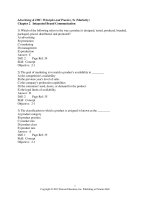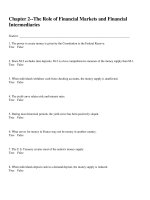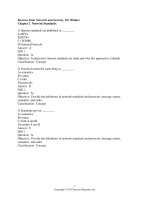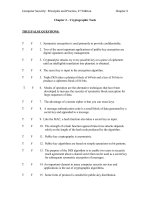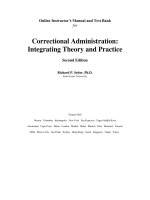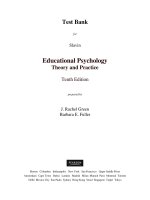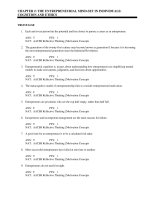Educational psychology theory and practice 10th edition slavin test bank
Bạn đang xem bản rút gọn của tài liệu. Xem và tải ngay bản đầy đủ của tài liệu tại đây (482.67 KB, 22 trang )
Test Bank
for
Slavin
Educational Psychology
Theory and Practice
Tenth Edition
prepared by
J. Rachel Green
Barbara E. Fuller
Boston Columbus Indianapolis New York San Francisco Upper Saddle River
Amsterdam Cape Town Dubai London Madrid Milan Munich Paris Montreal Toronto
Delhi Mexico City Sao Paulo Sydney Hong Kong Seoul Singapore Taipei Tokyo
Copyright © 2012, 2009, 2006, 2003, 2000, 1997, 1994, 1991, 1988, 1986 by Pearson
Education, Inc., publishing as Allyn & Bacon, 501 Boylston St, Suite 900, Boston, MA,
02116.
All rights reserved. The contents, or parts thereof, may be reproduced with Educational
Psychology: Theory and Practice, Tenth Edition, by Robert E. Slavin, provided such
reproductions bear copyright notice, but may not be reproduced in any form for any other
purpose without written permission from the copyright owner.
To obtain permission(s) to use the material from this work, please submit a written
request to Permissions Department, 501 Boylston Street, Suite 900, Boston, MA 02116;
fax your request to 617-671-2290; or email
ISBN-10: 0-13-703437-7
www.pearsonhighered.com
ISBN-13: 978-0-13-703437-6
CONTENTS
Chapter 1
Educational Psychology: A Foundation for Teaching
Answer Key
1
16
Chapter 2
Cognitive, Language, and Literacy Development
Answer Key
19
35
Chapter 3
Social, Moral, and Emotional Development
Answer Key
38
50
Chapter 4
Student Diversity
Answer Key
53
66
Chapter 5
Behavioral Theories of Learning
Answer Key
69
82
Chapter 6
Information Processing and Cognitive Theories of
Learning
Answer Key
85
100
Chapter 7
The Effective Lesson
Answer Key
103
115
Chapter 8
Student-Centered and Constructivist Approaches to
Instruction
Answer Key
118
Chapter 9
Grouping, Differentiation, and Technology
Answer Key
135
148
Chapter 10
Motivating Students to Learn
Answer Key
151
164
Chapter 11
Effective Learning Environments
Answer Key
167
180
Chapter 12
Learners with Exceptionalities
Answer Key
183
196
Chapter 13
Assessing Student Learning
Answer Key
199
214
Chapter 14
Standardized Tests and Accountability
217
Answer Key
230
132
Chapter 1
EDUCATIONAL PSYCHOLOGY: A FOUNDATION FOR TEACHING
Multiple Choice
1) Which of the following statements about the role of educational psychology in teacher education is
accurate?
A) Educational psychology tells teachers what to do in order to be effective in the classroom.
B) Educational psychology course work focuses on subject matter knowledge rather than pedagogical
knowledge.
C) Educational psychology provides teachers with research-based principles to guide their teaching.
D) Educational psychology is the study of learning theory without regard to classroom application.
2) Which of the following statements best expresses the text author's view of the importance of subject matter
knowledge in effective teaching?
A) It is the single indispensable ingredient in effective teaching.
B) It is more important than communicating knowledge to students.
C) It is of little importance when compared to qualities such as self-discipline, leadership, and enthusiasm.
D) It is a good start; necessary, but not sufficient.
3) According to the text author, knowledge of how to transmit information and skills to students is:
A) sufficient for effective teaching.
B) at least as important as knowledge of what to teach.
C) no different from knowing the subject matter well.
D) not as important as knowledge of what to teach.
4) Teachers who demonstrate skill in communicating with students possess:
A) tenure status.
B) advanced degrees in their disciplines.
C) pedagogical knowledge.
D) teaching licenses.
5) All of the following teacher actions are pedagogically sound EXCEPT:
A) considering prerequisite skills needed to understand new ideas.
B) engaging students in active learning that leads to understanding.
C) concluding that the required subject matter will not interest the students.
D) taking into account the intellectual characteristics of students.
6) Content knowledge is to "what to teach" as ________ is to "how to teach."
A) ethnography
B) discipline
C) prerequisite
D) pedagogy
1
Chapter 1 – Educational Psychology: A Foundation for Teaching
7) According to your text author, can good teaching be taught?
A) Yes, good teaching strategies can be learned and applied.
B) No, there are too many personality factors to be considered.
C) Yes, but it can only be taught to those who demonstrate above average intelligence.
D) No, teachers are born, not made.
8) During a social studies class, two students at the back of the room whisper to each other about the dance on
Saturday night. The teacher moves near the two students, but does not stop the discussion about President
Johnson's Great Society. The students stop whispering to each other. Which principle of effective teaching
is being used?
A) Use the discipline problem as a teaching tool.
B) Use the mildest intervention possible.
C) Wait until minor problems become major before intervening.
D) State rules, give examples, and then restate rules.
9) Teachers who think about the outcomes they want for their students and how each decision they make
moves students toward those outcomes:
A) are novice teachers.
B) will lose students' attention.
C) are focused mainly on subject matter knowledge.
D) are intentional teachers.
10) Ms. Marano has a strong sense of teacher efficacy. Which of the following is she most likely to believe?
A) Students' potential for academic achievement comes down to how much ability they inherited.
B) Students with a negative home environment cannot be reached.
C) A teacher's actions are a major influence on a student's level of success.
D) Success will come when a teacher is lucky enough to get a "good class."
11) According to Bandura (1997), teachers who have strong teacher efficacy are likely to:
A) decrease the amount of effort invested in teaching, when students fall short of academic goals.
B) accept the fact that some students will never succeed.
C) blame students' failure on parents.
D) persist in their efforts, even when students fail.
12) Intentional teachers become expert by engaging in all of the following activities EXCEPT:
A) upgrading and examining their teaching practices.
B) using their own students' responses to guide instructional decisions.
C) unquestioning adherence to the methods learned during teacher training.
D) reading and attending conferences to learn new ideas.
2
Chapter 1 – Educational Psychology: A Foundation for Teaching
13) According to the text author, what is most likely the major difference between teachers with 20 years of
experience and teachers with one year of experience 20 times?
A) age
B) relationships with principals
C) ability to reflect
D) content knowledge
14) From studies in educational psychology, we know that:
A) scolding students for misbehavior will result in better behavior.
B) whole group instruction is better than individual instruction.
C) student achievement increases when independent study strategies are used.
D) mixed-ability grouping is more effective than same-ability grouping.
15) Ideas that explain relationships between factors are called:
A) theories.
B) laws.
C) principles.
D) hypothesis.
16) What is the main purpose of theory development?
A) Theories gather data that prove cause and effect.
B) Theories identify principles that have been thoroughly tested.
C) Theories explain relationships between two factors.
D) Theories synthesize laws and principles.
17) Which one of the following statements about educational psychology is accurate?
A) Progress in how we come to understand behavior and learning is a slow and uneven process.
B) Often, a single study will provide breakthrough evidence to extend theories.
C) Theories break down laws and principles so that they can be studied in their most pure form.
D) An example of a theory would be that discovery learning increases student learning.
18) It is probably true that the most important things that teachers learn about teaching take place:
A) in liberal education programs.
B) in departments of education.
C) in graduate school.
D) while on the job.
19) Which of the following statements about theories is accurate?
A) The quality, accuracy, and usefulness of theories are what determine, ultimately, a teacher's success.
B) Theories are based on clearly established outcomes and are thus rarely changed once formulated.
C) Theories are common in the hard sciences but not appropriate for education.
D) Theories evolve and gain acceptance relatively quickly.
3
Chapter 1 – Educational Psychology: A Foundation for Teaching
20) One aim of educational psychology is to:
A) find a unified method of teaching all learners.
B) eliminate rigorous teaching licensing policies.
C) test theories that guide the actions of teachers.
D) turn laws into useful theories.
21) When you combine objective research with common sense, the result is:
A) decreased quality in decision making.
B) effective teaching.
C) self-regulated learning.
D) inconsistent student achievement.
22) Which of the following statements best sums up the role of research in teaching?
A) Decision making, when based on research, is free of context.
B) Common sense has no place in instructional decision making.
C) No theory, research, or book can tell teachers what to do in a given situation.
D) Educational psychology research can be translated directly into instructional effectiveness.
22) Which of the following components of sound teacher decision making is FALSE?
A) Sound decision making depends on the objectives the teacher has in mind.
B) Sound decision making depends on the situation within which a problem arises.
C) It is necessary to combine principles and theories with common sense when making decisions.
D) Principles and theories should be isolated from context.
23) Based on your textbook author's conception of effective teaching, which of the following statements is true?
A) Knowing what research prescribes will ensure that the most effective teaching decisions will be made.
B) What were effective strategies 10 years ago will not work well today.
C) Common sense may be appealing, but it usually results in poor judgment and lower student success.
D) More weight should typically be given to the teacher's informed judgment of a classroom situation, than
to direct prescriptions from research findings.
24) The essence of a variable is that it:
A) ensures that two groups are equivalent.
B) creates special treatments and examines their effects.
C) synthesizes principles and laws.
D) can have more than one value.
4
Chapter 1 – Educational Psychology: A Foundation for Teaching
25) A researcher wants to study the effects of rewards on motivation. Two groups of students are set up; one
group receives rewards for its efforts and the other group does not. In order to ensure that the two groups are
essentially equivalent, what procedure should the researcher use?
A) Have students count off by twos.
B) Randomly assign students to groups.
C) Put all students who are motivated by awards in one group.
D) Let students choose the group to which they would like to belong.
27) Which of the following is an example of random assignment?
A) The first half of the class that enters the classroom is put in one group; the remaining students are
assigned to another group.
B) Students whose last name begins with the letters A – L are assigned to one group; the remainder are
assigned to another group.
C) Students who roll an odd number on a die are assigned to one group; those who roll an even number are
assigned to another.
D) Students are allowed to choose the group to which they prefer to belong.
28) A math teacher randomly assigns one group of students to use computers and one group to use work sheets
when learning fractions. The teacher then compares the two groups by giving both groups a test of fractions
knowledge. What type of research was conducted?
A) descriptive study
B) correlational study
C) ethnography
D) experiment
29) Studies demonstrating that differences in findings can be attributed to the treatment given are said to have
high:
A) correlational coefficients.
B) applicability.
C) generalizabilty.
D) internal validity.
30) Which of the following research types attempts to control all factors except those created by the treatment,
while remaining relevant to real life?
A) correlational study
B) randomized field experiment
C) single case study
D) laboratory experiment
5
Chapter 1 – Educational Psychology: A Foundation for Teaching
31) A teacher experimented with different approaches to instruction in a class. Although all of the conditions of
the experiment could not be controlled, the teacher's study was meaningful to real students in real
classrooms because it followed all the rules of good research. Therefore, the
A) study can be replicated with consistent results.
B) results would be the same across cultures and contexts.
C) results show a high degree of external validity.
D) findings will predict effective instruction in all third grade classrooms.
32) In a study, students were randomly assigned to classes receiving individual tutoring or no tutoring. The
students who did not receive tutoring are called the:
A) control group.
B) placebo group.
C) pilot group.
D) experimental group.
33) In one study, teachers were assigned to either group A, which received additional training in teaching
strategies, or group B, which received no training. Group A is called the:
A) pilot group.
B) control group.
C) placebo group.
D) experimental group.
34) In some situations a randomized field experiment may not be possible, because teachers cannot be assigned
to treatments. In such cases equivalence of experimental and control groups may be established using
matching, rather than random assignment. Compared with the randomized field experiment, the field
experiment that uses matching has:
A) higher external validity.
B) lower internal validity.
C) higher internal validity.
D) lower external validity.
35) After a new hand-raising rule was implemented, a special education teacher collects data on a student's
hand-raising behavior. What type of research is this?
A) correlational study
B) randomized field experiment
C) single case experiment
D) laboratory experiment
6
Chapter 1 – Educational Psychology: A Foundation for Teaching
36) A teacher notes the average number of students who clean up their materials each day for one week. The
teacher then implements a reinforcement program for neatness and observes the students' neatness behavior
for another week. What type of research is this?
A) correlational study
B) single case experiment
C) randomized field study
D) laboratory experiment
37) A researcher can understand the results of a single case study by:
A) statistically comparing the experimental and control groups.
B) talking to the participants and noting their ideas.
C) statistically comparing the results from the lab and the field.
D) graphing the results and analyzing the graphs.
38) In single-case experiments, examination of graphed results would generally be used for:
A) deciding about whether results are clear enough to accept.
B) situations in which common sense is at odds with research.
C) selecting experimental methodologies that "meet the eye."
D) determining whether a correlation is statistically significant.
39) A researcher found that students who scored high on a test of reading achievement also scored high on a
self-esteem inventory. The researcher can say that reading achievement and self-esteem are:
A) positively correlated.
B) internally correlated.
C) negatively correlated.
D) externally correlated.
40) Which of the following examples depicts a negative correlation?
A) Students who had the highest grade point averages received the highest math scores.
B) Students who studied for the greatest length of time prior to a math test received the highest scores.
C) Students who were absent the least prior to a math test had the highest scores.
D) The amount of time students studied for a math test was unrelated to the scores they received.
41) A researcher has completed a study correlating middle school students' science interests and science
achievement. The results of the study will show:
A) how a single student who is low or high on one variable scores on the other.
B) the degree of relationship between the two variables.
C) what happens when one of the two variables is kept constant for two or more groups.
D) how one variable causes the other.
7
Chapter 1 – Educational Psychology: A Foundation for Teaching
42) When the values of one variable are high, the values of the other are also high. What type of correlation is
being described?
A) neutral
B) positive
C) uncorrelated
D) negative
43) A music teacher finds that the amount of time students spend listening to rap music is negatively correlated
with grades in music class. Based on these results, the teacher might conclude that listening to rap music
A) causes the high grades.
B) is associated with high grades.
C) causes the low grades.
D) is associated with low grades.
44) A positive correlation would most likely exist between:
A) school achievement and ability to ride a bicycle.
B) singing ability and academic achievement.
C) motivation to learn and academic achievement.
D) hours spent playing video games and writing ability.
45) A student has been absent for many days during a semester; so, the teacher meets with the student's parents.
The teacher remarks that the more days absent from school, the worse student’s grades tend to be. What
type of correlation is the teacher suggesting there is between attendance and achievement?
A) neutral
B) uncorrelated
C) negative
D) positive
46) A teacher suspects that students who take more time to complete examinations will tend to earn higher
scores. If the teacher is correct, the resultant correlation between completion time and performance will be:
A) negative.
B) causal.
C) zero.
D) positive.
47) You are reading a description of a correlational study in which the author concludes that aggression in class
causes poor grades. Which of the following reactions to the author's conclusion is appropriate?
A) The author may be correct but cannot make a cause-effect conclusion from a correlational study.
B) The author is incorrect since aggression cannot be measured.
C) The author is correct in making the conclusion.
D) The author's conclusion is wrong since a correlational study cannot demonstrate a relationship between
two factors.
8
Chapter 1 – Educational Psychology: A Foundation for Teaching
48) A type of research in which an observer studies natural events as they occur in a social setting is called
A) quantitative research.
B) descriptive research.
C) correlational research.
D) cause-and-effect research.
49) Why would a researcher conduct an ethnographic study?
A) to explore a new context for conducting research
B) to establish cause-and-effect relationships between variables
C) to validate a principle or law
D) to prove a theory
50) An experimenter sits in the back of a classroom for three months in a school for students with special needs.
Students' behaviors are observed as a new teaching method is used. What type of study is this?
A) ethnography
B) experimental
C) lab experiment
D) correlational
51) Which of the following procedures is used in descriptive research?
A) random assignment
B) interviews
C) control groups
D) treatments of variables
52) A developmental psychologist observes and then synthesizes observations into a theory showing how
individuals develop cognitively over time. What type of research is being conducted?
A) correlational
B) descriptive
C) laboratory
D) experimental
53) A benefit of action research is that:
A) it gives pupils a more active role in research design than they have in other types of descriptive research.
B) professionals are directly involved in the program under study, which may bring great insight to the
investigation.
C) the data gathering process meets the highest standards of objectivity.
D) it has higher internal validity than experiments.
9
Chapter 1 – Educational Psychology: A Foundation for Teaching
54) As educational polices tend to lag behind, an emphasis on 21st century skills is designed to
assist the educator in:
A) thinking about curriculum and teaching methods.
B) the integration of technology and different forms of assessment.
C) both A and B.
D) neither A nor B.
55) Initiative and self-direction are exemplified by which category of 21st century skills?
A) core subjects
B) learning and innovation skills
C) information and media technology skills
D) life and career skills
56) During this type of research a school employee would try out a new strategy, collect data,
and debrief with other personnel on its effective components.
A) descriptive research
B) action research
C) correlational study
D) cooperative research
57) A good example of talking teaching would be to:
A) read a journal.
B) join a book club.
C) get student feedback.
D) none of the above.
58) What is Standard 8 of the Interstate New Teacher Assessment and Support Consortium?
A) knowledge of human development and learning
B) partnership
C) classroom motivation
D) assessment of student learning
10
Chapter 1 – Educational Psychology: A Foundation for Teaching
True/False
59) Educational psychology is the study of learners, learning, and teaching.
60) Pedagogy is the study of academic content knowledge.
61) Effective instruction is simply a matter of one person with more knowledge transmitting it to another.
62) According to the text author, good teaching can be taught.
63) One attribute that is characteristic of outstanding teachers is intentionality.
64) Intentional teachers keep instructional goals in mind when making decisions about students.
65) Critical thinking skills for teachers include the use of logical and systematic approaches to educational
practices.
66) Laws are principles that have yet to be thoroughly tested.
67) Principles, theories, and laws are the products of research.
68) Research + Effective Teaching = Common Sense.
69) A variable is anything that has just one value.
70) Laboratory experiments may have little relevance to real-life situations.
71) If achievement in reading goes up as does achievement in math, the variables can be said to be negatively
correlated.
72) Descriptive research has less objectivity than experimental research.
73) Surveys, ethnographies, and action research are all examples of descriptive research.
74) Creativity, critical thinking, and problem solving are all examples of the learning and
innovation skills identified by Azzam and Graseck.
75) The Partnership for 21st Century Skills has created a framework that consists of five broad
categories.
76) Financial literacy is a core subject in the Partnership for 21st Century Skills.
77) Teacher-oriented websites and blogs offer the best opportunity to share advice and
observations.
11
Chapter 1 – Educational Psychology: A Foundation for Teaching
Short Answer Write the word or phrase that best completes each statement or answers the question.
78) The discipline or field about learners, learning, and teaching.
79) The study of teaching and learning with application to the instructional process.
80) Teachers who do things for a reason, on purpose.
81) The degree to which teachers feel that their own efforts determine the success of their students.
82) Sets of principles and facts that attempt to explain some phenomenon.
83) Individual principles that have been thoroughly tested.
84) These explain relationships between factors.
85) A systematic procedure used to study the effects of a treatment.
86) The degree to which the results of a laboratory experiment can be directly attributed to the treatment studied
rather than other factors.
87) A type of research in which a single participant's behavior may be observed over a period of time.
88) A type of research that explores the degree to which two variables are related.
89) A type of nonexperimental study aimed at systematically identifying and gathering detailed information
about something.
90) When teachers think about the outcomes they desire in their lessons and how each decision made moves a
student toward these objectives, what are they demonstrating?
91) A logical and systematic approach to dilemmas found in practice and research are essential in the
development of which skill?
92) 21st century thinking and teaching skills can be traced back to the progressive philosophies of which
individual?
93) What is the creation of a highly artificial, structured setting that exits for a brief period of time?
94) What is the most frequently used research method in educational psychology?
12
Chapter 1 – Educational Psychology: A Foundation for Teaching
Essay
95) What personal and professional characteristics are necessary for effective teaching?
96) A teacher wants to know: Do students behave better in class when they help to create classroom rules or do
they behave better when teachers create the rules alone? How would you go about setting up a study to
answer this question?
97) Define and compare external validity and internal validity. Given your personal values, which do you feel is
more important to emphasize in educational research? Explain the rationale for your choice.
98) You are interested in how teacher feedback on homework (e.g., "good going" or "more detail needed")
influences the quality of subsequent homework. Describe how this question might be studied using each of
the following: 1) laboratory experiment; 2) single-case experiment; and 3) randomized field experiment.
99) Give examples of relationships in the educational environment that would likely yield a positive correlation,
a negative correlation, and no correlation. For each example, specify what kind of change in one variable is
associated with what change in a second variable.
100)
Describe a study you might conduct using a descriptive research design.
101)
Consider the following research finding:
Finding A: It was reported that students who receive more homework obtain higher grades.
Why is this type of research called correlational rather than experimental?
How strongly does Finding A support the conclusion that spending time on homework causes
students to obtain higher grades?
Now compare Finding A to the following:
Finding B: It was reported that students who own cell phones obtain higher grades.
How strongly does Finding B support the conclusion that owning a cell phone results in more
learning?
In what way do these two findings differ? Does one tell us more than the other about how
students achieve higher grades?
13
Chapter 1 – Educational Psychology: A Foundation for Teaching
102) Mr. Duvall enters his classroom on the first day of the fall semester. This is his first year of teaching
10th grade English at Southview High School. Although he is a little nervous, he believes that his
training at the state university and his student teaching experience have prepared him well for this day.
As he attempts to introduce himself to his new students, a group of students at the back of the room
begins talking to each other in voices loud enough to disturb the class. He moves to the back of the
classroom, thinking that his presence near the students will quiet them; however, when he gets within a
short distance of the students, they talk louder.
There are several actions that Mr. Duvall can take and several theories to support his decision.
Based on theories presented in the chapter, what do you think he should do and why? Write an ending to
the story that demonstrates a positive solution to the problem.
14
Chapter 1 – Educational Psychology: A Foundation for Teaching
103)
Below is a chart for experimental, correlational, and descriptive research. Fill in the missing
information, which is indicated by an X.
EXPERIMENTAL RESEARCH
Goals
Forms
Test effectiveness
of a treatment
Examples
Laboratory study
X
Randomized field study
Teaching math using manipulatives
is more effective than using
traditional approaches
Single Case Study
X
CORRELATIONAL RESEARCH
Goals
Forms
Look for
relationships
between variables
Examples
Positive correlation
X
X
The fewer days students are absent
from school, the higher their math
scores
No Correlation
Student achievement in social studies
and musical ability.
DESCRIPTIVE RESEARCH
Goals
Forms
X
Examples
Surveys
Students are in favor of an open
lunch.
Interviews
Adolescent females describe
themselves in positive terms.
Ethnography
Study the meaning and consequence
of desegregation at three high
schools.
15
Chapter 1 – Answer Key
CHAPTER 1 ANSWER KEY
1) C
25) D
49) A
73) TRUE
2) D
26) B
50) A
74) TRUE
3) B
27) C
51) B
75) FALSE
4) C
28) D
52) B
76) TRUE
5) C
29) D
53) B
77) TRUE
6) D
30) B
54) C
78) educational
psychology
7) A
31) C
55) D
79) pedagogy
8) B
32) A
56) B
9) D
33) D
57) B
80) intentional
teachers
10) C
34) B
58) D
81) teacher efficacy
11) D
35) C
59) TRUE
82) theories
12) C
36) B
60) FALSE
83) laws
13) C
37) D
61) FALSE
84) principles
14) D
38) A
62) TRUE
85) experiment
15) C
39) A
63) TRUE
86) internal validity
16) D
40) C
64) TRUE
87) single-case
experiment
17) A
41) B
65) TRUE
88) correlational study
18) D
42) B
66) FALSE
89) descriptive study
19) A
43) D
67) TRUE
90) intentionality
20) C
44) C
68) FALSE
91) critical thinking
21) B
45) C
69) FALSE
22) C
46) D
70) TRUE
23) D
47) A
71) FALSE
24) D
48) B
72) TRUE
92) John Dewey
16
93) laboratory
experiment
94) correlational
study
Chapter 1 – Answer Key
95)
First and foremost, teachers need to possess subject matter knowledge (knowing
what to teach) and pedagogical knowledge (knowing how to teach). Other
personal qualities, such as warmth, humor, empathy, hard work, leadership,
enthusiasm, a contagious love of learning, and speaking ability, are highly
desirable, but are not enough. A meshing of all these professional and personal
characteristics will most likely produce the strongest teachers.
96)
The first step in the research process would be to create two groups using random
assignment. Group one would consist of students who help make classroom rules.
Group two would consist of students who did not participate in rule making. The
teacher could then count the number of rule violations for each group, draw
conclusions from the data, and answer the question as to which strategy is most
effective.
97)
Internal validity, which is established in laboratory experiments, allows the
researcher to conclude that experimental outcomes are due to the effects of
treatments and not of extraneous factors. High internal validity sometimes comes
at the cost of external validity, which is the applicability of the findings to some
real-life problem.
98)
(1) Laboratory experiments require tight control. Students would be randomly
assigned to an experimental group (comments) or a control group (no comments).
Comments would be systematically given to the first group over time. The second
group would complete identical assignments, but not receive comments. The
assignments of both groups would be evaluated. (2) Single case experiments
would involve one group of students. No comments on homework would be
given. Results would be evaluated. Then, comments would be introduced and
analyzed. (3) A randomized field experiment would involve two classes. The
design would be the same as for the laboratory experiment, but methods would be
more natural and less controlled.
99)
An example of a positive correlation might be students whose achievement level
increases as their hours of study increase. A negative correlation might be
students whose achievement level decreases as their number of days absent
increases. There is most likely no relationship between student achievement and
shoe size.
100)
A study could be conducted of life in well-funded and poorly funded schools, or
of tracked or untracked middle schools. Research in developmental psychology is
often descriptive in nature.
17
Chapter 1 – Answer Key
101)
Both findings are correlational, because they show only that a change in one
variable is associated with a change in another. They cannot show a cause/effect
connection because they do not manipulate any treatment.
Neither finding tells us what causes students to obtain high grades. The difference
between the studies is that a causal connection between spending time on
homework and getting good grades (the incorrect interpretation of Finding A) is
plausible, whereas the idea that owning cell phones causes high grades (incorrect
interpretation of Finding B) is implausible. It is easier to see, looking at Finding
B, that correlation does not prove causation; looking at Finding A it is very
tempting to conclude (incorrectly) that a causal relationship has been
demonstrated.
102)
Mr. Duvall could reprimand the students (a reprimand is a form of punishment
and the students would behave to avoid punishment), ignore their talking (calling
attention to the talking could be a punishment), send the students to the office
(depriving the students of their audience), or punish the whole class (get other
students to be concerned about the talking).
103)
A laboratory study example could be to study the effects of two groups; one group
is rewarded for using felt markers while the other is not.
A single case study example could be to study how one student's behavior
changes over time after the introduction of a contract for grade system.
An example of a positive correlation could be an increase in test scores with an
increase in praise for hard work.
The fewer days students are absent from school, the higher their math scores is an
example of a negative correlation.
The goal of descriptive research is to observe and describe events in a natural
environment.
18
Chapter 1 – Answer Key
Chapter 2
COGNITIVE, LANGUAGE, AND LITERACY DEVELOPMENT
19

